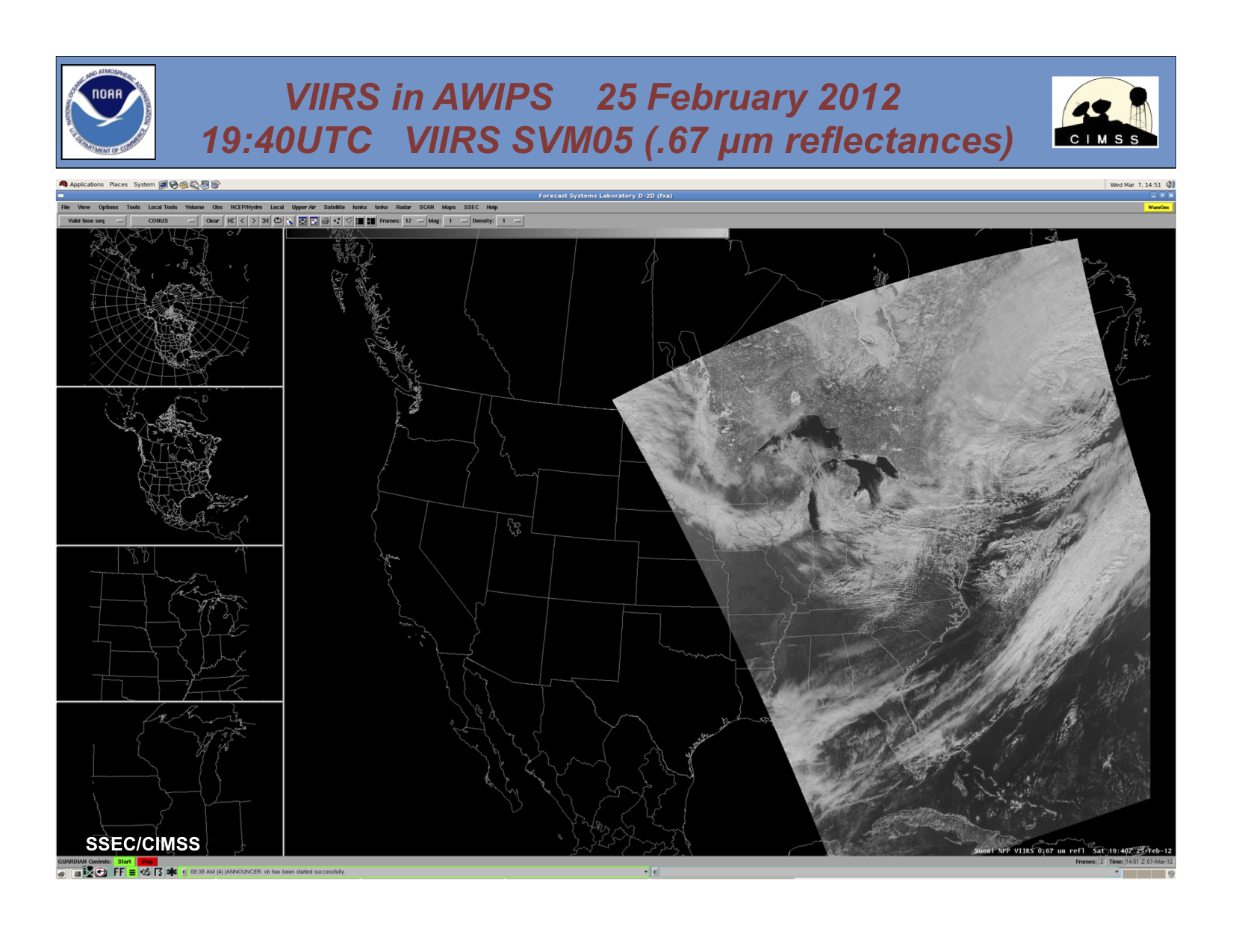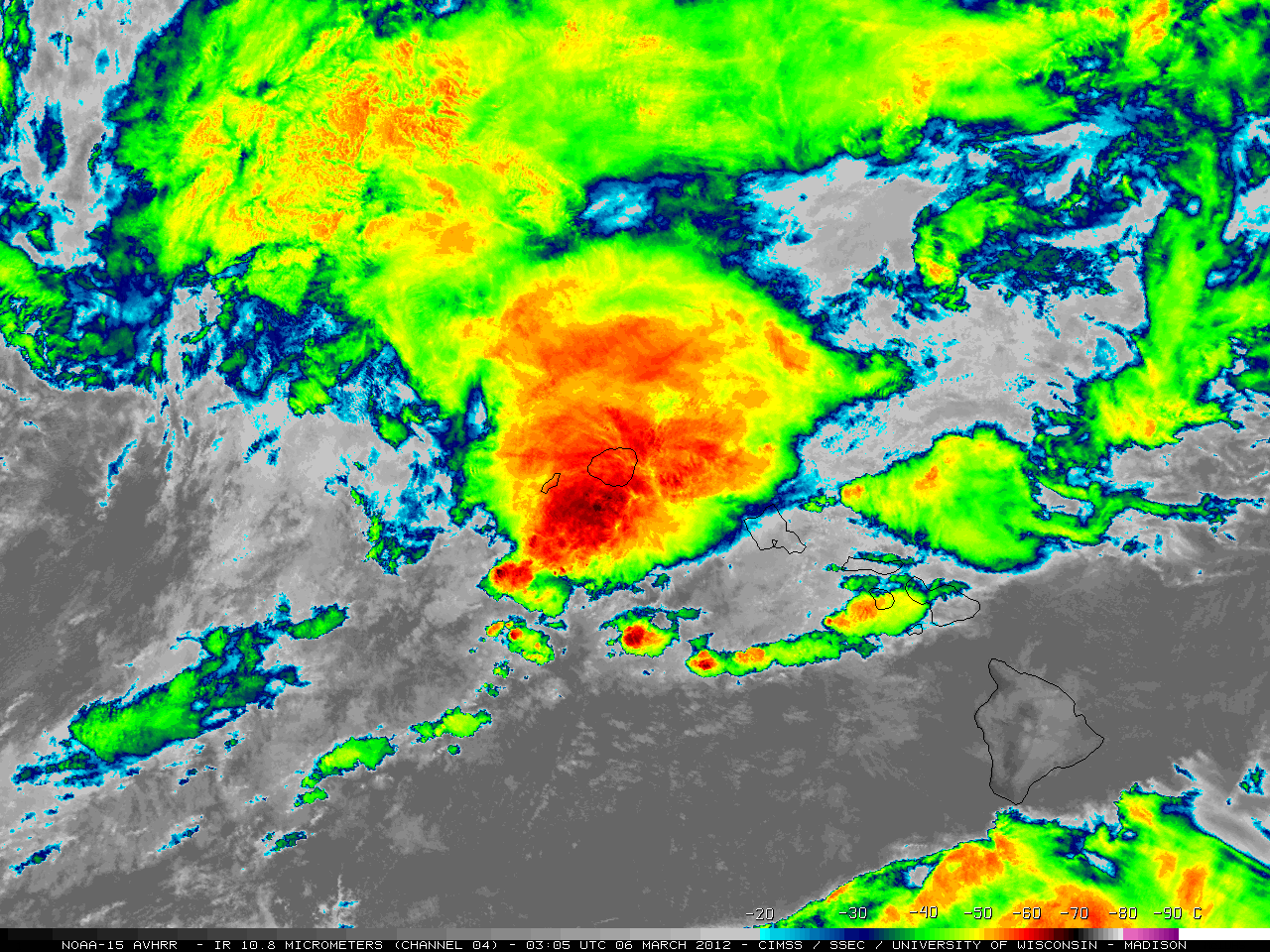
[ Archive ]

 |
ASPB and CIMSS Weekly Report
[ Archive ] |
 |
IN THE PRESS:
ITEMS FOR THE ADMINISTRATOR:
ITEMS FOR THE ASSISTANT ADMINISTRATOR:
ITEMS FOR THE OFFICE DIRECTOR, STAR:
New Model Transitioned into NHC Operations: The Probability of Eyewall Replacement Cycle [P(ERC)] model has been officially accepted into the standard operational suite of forecast tools at the NOAA National Hurricane Center. The model was transitioned to operations and tested during the 2010 and 2011 hurricane seasons as part of the United States Weather Research program Joint Hurricane Testbed project. The model provides a probability that an eyewall replacement cycle will occur within specified forecast lead-times and has been verified as skillful. Eyewall replacement cycles have a dramatic effect on hurricane intensity and size, and this new information is expected to improve intensity forecasting skill. The model was created and transitioned to operations by James Kossin, Matthew Sitkowski, and Christopher Rozoff. (J. Kossin, NOAA/NCDC, 608-265-5356, M. Sitkowski, CIMSS/AOS, C. Rozoff, CIMSS)
Research Highlight in Nature Climate Change: An upcoming article titled "A Cloudier Arctic Expected with Diminishing Sea Ice" by Yinghui Liu (Cooperative Institute for Meteorological Satellite Studies, CIMSS), Jeff Key (NOAA/NESDIS), Zhengyu Liu (Atmospheric and Oceanic Sciences, UW-Madison), Xuanji Wang (CIMSS), and Stephen J. Vavrus (UW-Madison), to be published in Geophysical Research Letters, has been chosen as a research highlight in Nature Climate Change. The authors quantified the feedback of recent Arctic sea ice variations on cloud cover using satellite data, and suggest that further warming and sea ice melt in coming years could lead to cloudier skies in the Arctic. (Y. Liu, CIMSS, 608-265-8620; J. Key, E/RA2, 608-263-2605, jkey@ssec.wisc.edu)
ITEMS FOR THE DIVISION CHIEF, CoRP:
First VIIRS Data Imported into AWIPS: Suomi National Polar Partnership (Suomi NPP) Visible Infrared Imager Radiometer Suite (VIIRS) data were acquired, processed and converted into a format that could be displayed in the National Weather Service (NWS) Advanced Weather Interactive Processing System (AWIPS). The development of a portable tool to perform the transformation from VIIRS Science Data Records (SDR) to an AWIPS compatible format will be delivered to Direct Broadcast (DB) stations in Alaska and allow them to supply timely products to their respective NWS forecast offices. The data is valuable to forecasters because of the high spatial resolution of the data (about 1km from nadir to edge of scan), the high quality of the data and the rapid distribution of the data through DB. Cooperative Institute for Meteorological Satellite Studies (CIMSS) personnel also plan to deliver NPP DB data to the NWS forecast offices that we currently supply with Aqua and Terra DB data. (R. Garcia, CIMSS, 608-262-8439, W. Straka III, CIMSS, D. Hoese, CIMSS, K. Strabala, CIMSS) (Click image to enlarge)
(Click image to enlarge)
Figure caption: First Suomi NPP VIIRS in AWIPS image, created using a portable tool that transforms VIIRS SDR into an AWIPS compatible format.
Two Manuscripts on Sounding Retrieval Published: Two manuscripts entitled "Sunglint impact on atmospheric soundings from hyperspectral resolution infrared radiances" and "Use of total precipitable water classification of a priori error and quality control in atmospheric temperature and water vapor sounding retrieval" have been published in the journal Advances in Atmospheric Sciences. Co-authors are Zhigang Yao, Eun-Han Kwon, Jun Li, Elisabeth Weisz and Jinlong Li (Cooperative Institute for Meteorological Satellite Studies, CIMSS). (Jun Li, CIMSS, Jun.Li@ssec.wisc.edu, 608-262-3755)
Interdepartmental Hurricane Conference: The Cooperative Institute for Meteorological Satellite Studies (CIMSS) and the NOAA/National Climatic Data Center (NCDC) had two presentations at the 66th Interdepartmental Hurricane Conference held in Charleston, South Carolina March 4-8. CIMSS researchers were involved as collaborators in a number of other talks as well. The two CIMSS/NOAA presentations highlighted research to operations work funded by NOAA. Jim Kossin (NOAA/NCDC at CIMSS), with co-authors Matthew Sitkowski, William Lewis, and Christopher Rozoff, presented on "A new secondary eyeball formation index: Transition to operations and quantification of associated hurricane intensity and structure changes. Christopher Rozoff, with co-authors Christopher Velden (CIMSS), John Kaplan (NOAA/Hurricane Research Division), Tony Wimmers (CIMSS), and Jim Kossin, presented on "Improvements in the probabilistic prediction of tropical cyclone rapid intensification resulting from inclusion of satellite passive microwave observations". (C. Rozoff, CIMSS, 608-263-6733). (Click image to enlarge)
(Click image to enlarge)VISITORS:
EUMETSAT Visitors Learn About Direct Broadcast Package: EUMETSAT scientists Christelle Ponsard and Anders Soerensen spent a day visiting with the Space Science and Engineering Center (SSEC) Community Satellite Processing Package (CSPP) team to learn about the direct broadcast processing package for Suomi National Polar-orbiting Partnership (NPP) satellite. SSEC personnel described the status and challenges of the current Beta 2 instrument Science Data Records (SDR) and Environmental Data Records (EDR) packages, discussed version 1 release dates and future package enhancements. Christelle and Anders described plans at EUMETSAT for collection and dissemination of NPP data, including their plans to used CSPP as their NPP direct broadcast processing package. Areas of collaboration were discussed, and SSEC offered to become an official EUMETSAT Product Processing Node (PPN). (K. Strabala, CIMSS, 608-263-8752)
NEXT WEEK:
LOOKING AHEAD:
| Archived Weeklies Page | Submit a report item |